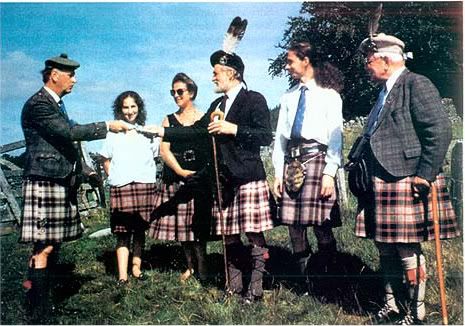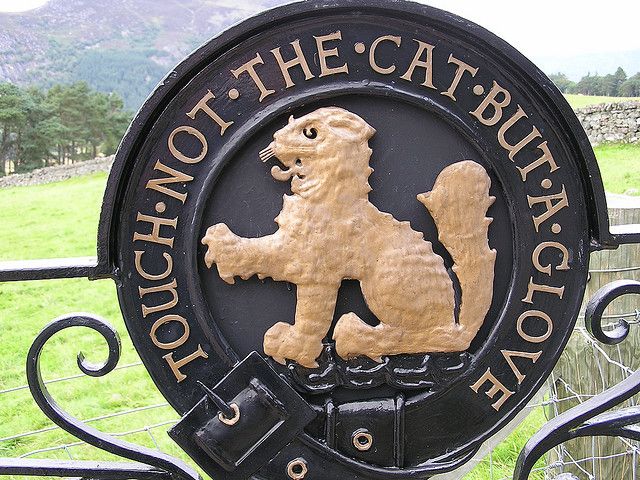|
-
The Highland Clans after 1745
I found this on the nationalarchives.gov.uk

No exact date for this document but some time around 1746
Source Links.
http://www.nationalarchives.gov.uk/p...t/highland.htm
http://www.nationalarchives.gov.uk/p...clans_list.htm
Chris.
-
-
Good find Chris and a most interesting document. Would be marvelous to be able to find the source and what use was to be made of it.
Shoot straight you bastards. Don't make a mess of it. Harry (Breaker) Harbord Morant - Bushveldt Carbineers
-
-
 Originally Posted by Downunder Kilt

Good find Chris and a most interesting document. Would be marvelous to be able to find the source and what use was to be made of it.
I suspect after Culloden the government wanted to see if there was any further possibility of another uprising and wanted to know how many men could be raised in the Highlands. It does not look as though there was that many fighting men left but 18,840 was still a significant number.
Not all the clans on the Jacobite side are named in this list as I suspect they were almost wiped out as was the case of the MacLarens.
Chris.
Last edited by chrisupyonder; 8th May 12 at 11:26 PM.
-
-
 Originally Posted by chrisupyonder

I suspect after Culloden the government wanted to see if there was any further possibility of another uprising and wanted to know how many men could be raised in the Highlands.
If the year is right, that sounds probable.
"It's all the same to me, war or peace,
I'm killed in the war or hung during peace."
-
-
That is truly interesting and very informative !
One can see a relavance between the number of men these clans could raise at the time of Culloden and which clans would later become fighting regiments in the British military , i.e. ( as shown above ) Argile , Athol , McKenzie , etc. , based upon the numbers in this document .
Last edited by MacGumerait; 9th May 12 at 12:43 AM.
-
-
What a great find! Thanks for sharing it with us.
-
-
 Originally Posted by Downunder Kilt

Good find Chris and a most interesting document. Would be marvelous to be able to find the source and what use was to be made of it.
I think that this is the list drawn up by Forbes of Culloden c1746-7. He was a prominent Hanoverian supporter and government agent in the Highlands. He also raised issues against the Act of Proscription arguing that it disproportionally affected the poor Highlander who was not politically active whereas the gentry got away fairly lightly as they could afford other cloths (and in many cases were exempt).
-
-
Not all the clans on the Jacobite side are named in this list as I suspect they were almost wiped out as was the case of the MacLarens.
Speaking of "wiped out", I find it interesting that they list MacGregor as a clan that could raise men. If I recall correctly, during the period of 1746, Clan MacGregor was still in the period during which they were not allowed to exist at all.
-
-
Very interesting indeed, thank you for sharing. I absolutely love the penmanship back then, no one writes like that anymore.
Macphersons.......500. I like the sound of that!
Naturally, I own a fantastic book that discusses in great detail and with historical accuracy, the part the Clan Macpherson played in the Rising of 1745, the skirmishes and battles throughout the Jacobite Campaign, leading to their eventual demise at Drumossie Moor (Culloden), and the flight of Prince Charles Edward Stuart assisted by "Cluny of the '45" as he is known to Macphersons. The book is entitled, "A Day's March to Ruin," by Dr. Alan Gibson Macpherson (one of our Clan Macpherson Historians)of St. John's, Newfoundland.
I have several copies of the paperback book if anyone is interested - perhaps I'll put detailed information up in the 'for sale' section. The book contains copies of actual letters between Prince Charles Edward Stuart and Cluny-Macpherson, as well as other notable Jacobites, throughout the book. A very, very compelling and interesting read, whether you are a Macpherson or not!

A Day's March to Ruin: A Documentary Narrative of the Badenoch Men in the 'Forty-Five and a Biography of Colonel Ewan Macpherson of Cluny, 1706-1764.

Clan Macpherson Memorial on the lands of Glentruim in Badenoch (Inverness-shire), given to the Clan Macpherson Association in 1996 by Euan Macpherson of Glentruim. The cairn is comprised of stones donated by Macphersons located all around the world and contains a gold plaque dedicated to the life and memory of Colonel Ewan Macpherson of Cluny, wartime leader and Chief to all Macphersons during the Jacobite Risings of the mid 18th-century.

Euan Macpherson of Glentruim handing over the deed to Ewen Macpherson of Talla-Shee, thus giving adequate land for the Clan Macpherson Memorial to be built.

A close-up of the detailed ironwork of the gate, featuring the Clan Macpherson badge.
CREAG DHUBH CLANN CHATAIN!!!
Last edited by creagdhubh; 11th May 12 at 12:54 PM.
Reason: Typo
-
-
Chris ,
I was wondering if this could have been a list of men that the clans could raise leading up to Culloden as it was fought in April of 1746 , however , I think I am wrong on that thought . After checking some hsitorical info ( see below ) I discovered there were only apprx 6,180 in the Jacobite army at Culloden . The info below is a bit lenghty , but I found it rather interesting so thought I would share it with everyone .
Best regards , Mike
Order of battle: Culloden, 16th April 1746
Jacobite army
Charles Edward Stuart
Colonel John William Sullivan
Escort troop
Fitzjames' Horse: 16 men.
Lifeguards: 16 men.
Commanded by Capt O'Shea. This unit was the prince's escort.
Lord George Murray's Division
Atholl Brigade: 500 men (3 battalions).
Raised not as a clan but as a feudal levy. Possibly consisted of 3 regiments. Suffered badly from desertion.
Cameron of Lochiel's Regiment: abt 650–700 men.
Led by Sir Donald Cameron of Lochiel. Regarded as one of the strongest Jacobite units, and as elite.
Stewarts of Appin or Appin Regiment: 250 men.
Led by Charles Stuart of Ardsheal. The regiment suffered from desertion. During the campaign it suffered 90 killed, 65 wounded.
Lord John Drummond's Division.
Lord Lovat's Regiment: abt 300 men.
Led at Culloden by Charles Fraser of Inverallochie, whose battalion was numbered at about 300. The Master of Lovat's battalion missed the battle by several hours.
Lady Mackintosh's Regiment: abt 350 men.
Sometimes referred to in secondary sources as Clan Chattan Regiment. A composite unit, like the Athole Brigate. Led by Alexander McGillivray of Dunmaglass. Lost most of its officers at Culloden.
Farquharson of Monaltrie's Battalion: 150 men.
Consisted of mostly Highlanders but not all. Described by James Logie as "dressed in highland clothes mostly". Included a party of MacGregors.
Maclachlans and Macleans: abt 200 men.
Commanded by Lachlan Maclachlan of Castle Lachlan and Maclean of Drimmin (who served as Lt Col). The unit campaigned as part of the Athole Brigade, though fought at Culloden for the first time as a stand alone unit.
Chisholms of Strathglass: abt 80 men.
This very small unit was led by Roderick Og Chisholm. Suffered very heavy casualties at Culloden.
Duke of Perth's Division.
MacDonald of Keppoch's Regiment. 200 men.
Commanded by Alexander MacDonald of Keppoch. This small regiment consisted of MacDonalds of Keppoch, MacDonalds of Glencoe, Mackinnons and MacGregors.
MacDonald of Clanranald's Regiment: 200 men.
Commanded by MacDonald of Clanranald, younger, who was wounded during the battle. Disbanded at Fort Augustus about 18 April 1746.
MacDonnell of Glengarry's Regiment: 500 men.
Commanded by Donald MacDonnell of Lochgarry. This regiment included a unit of Grants of Glenmoriston and Glen Urquhart.
John Roy Stuart's Division (reserve)
Lord Lewis Gordon's Regiment
John Gordon of Avochie's Battalion: 300 men.
Commanded by John Gordon of Avochie.
Moir of Stonywood's Battalion: 200 men.
Commanded by James Moir of Stonywood. The unit, unlike the others of this regiment, was made up largely of volunteers.
1/Lord Ogilvy's Regiment: 200 men.
Commanded by Thomas Blair of Glassclune.
2/Lord Ogilvy's Regiment: 300 men.
Commanded by Sir James Johnstone.
John Roy Stuart's Regiment: abt 200 men.
Commanded by Maj Patrick Stewart. Also known as the Edinburgh Regiment, because of where it was raised.
Footguards. abt 200 men.
Commanded by William, Lord Kilmarnock. A composite unit.
Glenbuchet's Regiment. 200 men.
Commanded by John Gordon of Glenbuchat.
Duke of Perth's Regiment: 300 men.
James Drummond, Master of Strathallan. The unit included a party of MacGregors.
Irish Brigade.
Garde Écossaise: 350 men.
Commanded by Lieutenant-Colonel Lord Lewis Drummond.
Irish Picquets: 302 men.
Commanded by Lieutenant-Colonel Walter Stapleton.
Cavalry
(Commanded by Sir John MacDonald of Fitzjames' Horse)
Right Squadron
Fitzjames' Horse: 70 men.
Commanded by Capt William Bagot.
Lifeguards: 30 men.
Commanded by David, Lord Elcho.
Left Squadron
Scotch Hussars: 36 men.
Commanded by Maj John Bagot.
Strathallan's Horse: 30 men.
Commanded by William, Lord Strathallan.
Artillery.
11 x 3-pounders.
Commanded by Capt John Finlayson.
1 x 4-pounders.
Last edited by MacGumerait; 9th May 12 at 10:43 PM.
-
 Posting Permissions
Posting Permissions
- You may not post new threads
- You may not post replies
- You may not post attachments
- You may not edit your posts
-
Forum Rules
|
|
Bookmarks